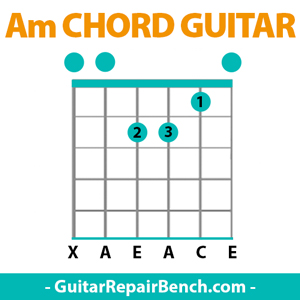 Playing an A minor chord on guitar is really easy because it has a few different finger positions and string variations going all the way up the guitar neck.
Playing an A minor chord on guitar is really easy because it has a few different finger positions and string variations going all the way up the guitar neck.
Am is a very popular acoustic guitar chord because tons of popular songs are written in the key of A minor. Everything from Stairway to Heaven to Bob Dylan’s All Along the Watchtower use this chord. It’s a great chord to start out playing on the guitar if you are a beginner because you can do so much with it.
Plus, it’s easy to play. Let’s check out some A minor chord music theory on the guitar and how to make the chord shapes with your fingers.
What is an A Minor Chord on Guitar?
Contents
What notes are in a Am chord?
A minor is a triad chord made up of by three notes: A – root –, C – the minor third (one and a half steps from the root), and E – the perfect fifth (three and a half steps from the root).
When working on A minor key, it’s important to keep in mind that this is the only minor key that does not use altered notes. In other words, it has no sharps or flats. All the notes are natural, just like it’s relative major key: C. The only time sharps and flats are played is when using the harmonic or melodic minor modes.
Thus, the A minor scale consists of the following: A – B – C – D – E – F – G – A
A Minor Chord Guitar Finger Positions
You can play the A minor chord on acoustic guitar in several different positions along the neck. Here are the most common chord position variations across the fretboard.
- Open chord
- 2nd position
- 5th position
- 7th position
- 9th position
- 12th position
How to Play an Open A minor Chord on Guitar
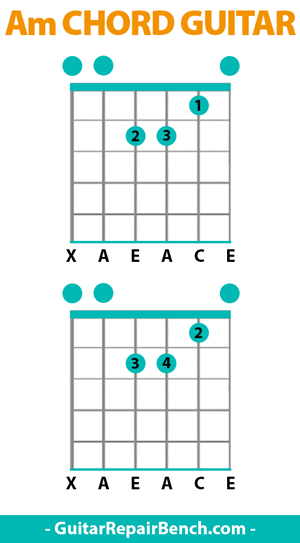 A minor can be played using two different open A minor chord variations and finger positions. Each variation is used for different reasons.
A minor can be played using two different open A minor chord variations and finger positions. Each variation is used for different reasons.
Open A minor Finger Position #1
You can start by placing your 1st finger on the 1st fret of the B string. After that, put your 2nd finger on 2nd fret of the D string. Lastly, set your 3rd finger on the 2nd fret of the G string.
Short tip for beginners: A minor open chord is quite an easy position to remember, since it’s the exact same fingering than the one corresponding to E major, only one string below. When approaching this chord, it’s important to consider that the E string should not be played – keep the A string as your bass note since open chords are always to be played in root position.
Open A minor Finger Position #2
The second variation of the open Am chord uses the same notes with a different finger pattern. Make the same A minor chord shape as the first position, but use one finger down for each.
So use your second finger on the B string, your third finger on the D string, and your fourth finger on the G string. You’ll notice that this is the same shape as the first variation, but it puts you in a position to move up the neck into a barre chord more effortlessly.
5 Different A Minor Chord Guitar Variations
How to Play an A minor Chord at the 2nd Fret
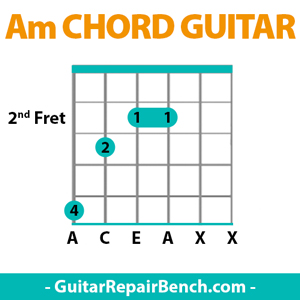 First, put your 2nd finger on the 3rd fret of the A string.
First, put your 2nd finger on the 3rd fret of the A string.
Now you can like up your first finger to barre it across the 2nd fret of the D and G strings.
This will make a small, invert A M chord. All it needs is the bass note.
Finally, put your 4th finger on the 5th fret of the low E string to add a low A bass note you’re your A M chord.
How to Play an Am Guitar Chord at the 5th Fret
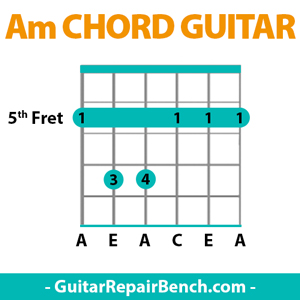 The fifth position A minor is the most popular barre chord shape for minor chords. It’s easy to make and easy to remember.
The fifth position A minor is the most popular barre chord shape for minor chords. It’s easy to make and easy to remember.
Simply, use your 1st finger to make a barre across all the strings on 5th fret.
Then, use your 3rd finger on the 7th fret of the A string and your 4th finger on the 7th fret of the D string.
Now strum everything! You could also just strum the bottom 4 strings if you want to have bassier sounding triad.
How to Play an Am Chord at the 7th Fret
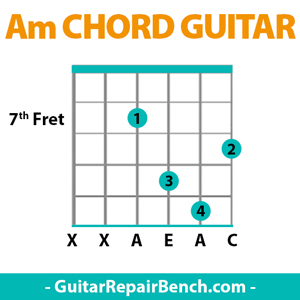 The Am chord in the 7th position is a bit tricky. It’s a partial chord that only uses the first 4 strings.
The Am chord in the 7th position is a bit tricky. It’s a partial chord that only uses the first 4 strings.
Begin by putting your 1st finger on the 7th fret of the D string.
Next, place your 3rd finger on 9th fret of the G string, and right after that, set your 4th finger on the 10th fret of the B string.
Lastly, put your 2nd finger on the 8th fret of the high e string. Now just strum the first 4 strings.
Guitar Chord Shape Tip: You might notice that this chord shape looks a lot like the open D minor chord. That’s because it is. It’s the same shape with a different finger pattern.
How to Play an A Minor Guitar Chord at the 9th Fret
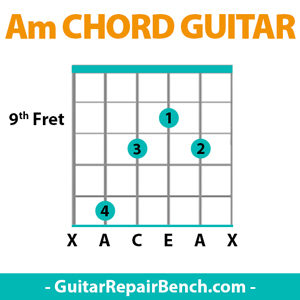 First, put your 3rd finger on the 10th fret of the D string.
First, put your 3rd finger on the 10th fret of the D string.
Next, place your first finger on the 9th fret of the G string and your 2nd finger on the 10th fret of the B string.
Finally, put your 4th finger on the 12th fret of the A string. Now you can strum all the all the strings or just the middle four strings.
A Minor Chord Guitar tip: The easiest way to play this chord is to start out by making the chord shape with your first three fingers. Once you have that triangle looking shape made, you just have to stretch your 4th finger over to hit the low A note to complete the chord.
How to Play an A Minor Chord at the 12th Fret
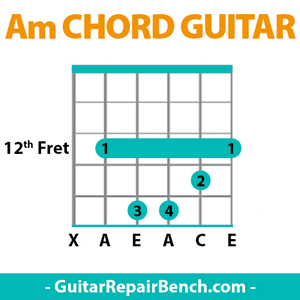 This Am-chord is exactly one octave higher than the first open chord that we learned at the beginning of this article. That means that this A minor guitar chord will look exactly like the open one, but instead of having the nut play the open strings, you will use your first finger to barre the strings on the 12th fret. Check it out in the A minor guitar chord chart.
This Am-chord is exactly one octave higher than the first open chord that we learned at the beginning of this article. That means that this A minor guitar chord will look exactly like the open one, but instead of having the nut play the open strings, you will use your first finger to barre the strings on the 12th fret. Check it out in the A minor guitar chord chart.
First, put your 3rd and 4th fingers on the 14th frets of the D and G strings, respectively.
Then use your 2nd finger to hold down the B string on the 13th fret.
Finally, use your 1st finger to barre the first 5 strings starting with the A. Then let it rock!
Tada! You now know how to play an A minor chord from one octave to another all the way up the guitar neck.
Am Guitar Chord Position Tip: You can either hold down the first 5 strings with your first finger on the 12th fret or you can hold down all 6 strings. By making a barre across the low E string, you’ll add another E note to the chord. Although it’s not the root note, it can give your chord a different dimension when inverting it and playing the 5th in the bass.
Now It’s Time to Start Playing
Now you know how to play an A minor on guitar! A minor is one of the most common chords on guitar because its fingering allows you to develop rich bass lines while keeping a static harmony.
If you are just starting to play guitar, Am is a great guitar chord for beginners. There’s so much you can do with it. A perfect example of this is the song “Is there anybody out there” by Pink Floyd. If you don’t know it, you should check it out.
Or you can learn how to play it when you sign up for a free trial of guitar lessons online. There’s no better way to learn new chords, songs, and skills than taking lessons. Plus, it makes practicing guitar fun! Check them out, you won’t regret it!

